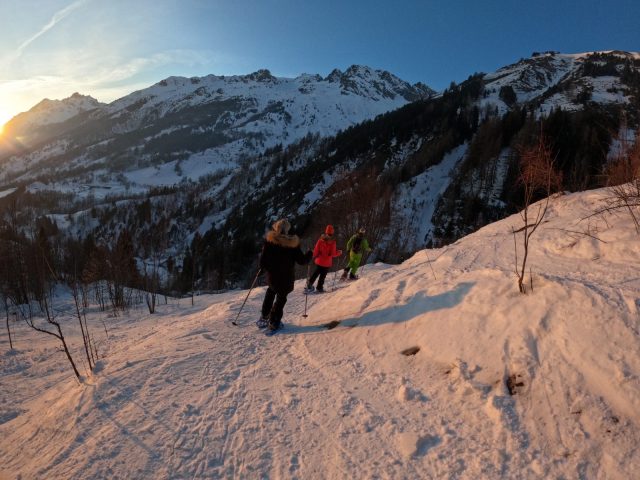A wild loop alternating between descents and climbs to discover the enchanting forest, the hamlet of La Villette and beautiful panoramas: a complete hike that will seduce you with its variety.
About : Snowshoeing : Un petit air de là bas
You pass through an area of fields that were once cultivated in the summer.
Spelt and buckwheat were used to feed men and animals during the long winter months. A time when living in autarky forced men to work hard to feed themselves and survive.
Our mountain is home to many ungulates (deer, roe deer, chamois, wild boar and others). Winter is synonymous with survival for them. The species make high altitude transhumance.
The snow cover is too heavy in their summer quarters, so the animals gradually move down to the areas where they do not sink so deep. Walking in the snow requires a great deal of energy and the snow-covered landscape offers little food. So the animals feed on what they can find: tree bark, bulbs found while digging, seed remains (beech fern, for example). The meadows are now out of reach and it is necessary to fight the snow, the cold, the wind, to find shelter. It is important to observe the fauna in silence, and to avoid stressing it further.
Minimum age: 5 years
Welcome: All rubbish must be brought back by the hikers. This rule applies along the trail. The forest environment must be preserved, avoid cutting branches or mutilating them.
Tips:
- Make sure that snow does not get into your shoes by using gaiters.
-While snowshoeing:
- Remember to release the heel of the snowshoe! For your information, the back of the foot is sometimes tied up when going downhill when there is a lot of snow.
- Go with poles, essential for balance.
- Don't hesitate to tap your snowshoe with the pole from time to time, it allows to remove some of the snow and thus to lighten your step.
- Foggy glasses are usually a good indicator of too much body heat or too rapid a change in body heat. If this happens, you can reduce your speed, the number of layers of clothing or simply ventilate by allowing cool air to enter under your windbreaker.
Guidebook with maps/step-by-step
Depart from the Tourist Office, take the escalator down to the cable car. From there, take the inclined lift stopping at level 1. Follow the road on the left down to the roundabout, and take the path to Les Combes, indicated by the yellow signs. This path winds through the fields and takes you to the mill, the first house on your left at the bottom of this first descent. Continue to the left towards Les Combes, La Villette. You cross the bridge over the Flumet stream, then head left to follow a path in the forest. The path leads to the arrival station of the Montfrais cable car. You go around it by the left, stay on the left because on 200m the itinerary is shared with skiers. For your own safety and that of other skiers, it is strongly recommended to keep to the left. A small downhill path invites you to the left, joining the old mill of La Villette, now restored. From here you cross the bridge and go up to the road, still continuing to the left. At the end of the road, you are in the hamlet of La Villette. And you continue on the road to the left, you continue on this road until it makes a hairpin turn to the left. A few metres after the bend, a path with yellow signs invites you to go back down. You then go down, still following this route, which ends up below the Tourist Office. Once on the road, to return to the Tourist Office, turn right and 150m further on, the Tourist Office square appears before you.
En bref
2 h 30
J+ : 288 m
4.5 km
Level bue - Medium
Map and GPX marking
Snowshoeing : Un petit air de là bas
Vaujany
Services
- Pets welcome
Services
Activities
- Duration of the session: 150 minutes
Tours
- Average duration of the individual tour: 150 minutes
Download
Opening
Subject to favorable weather.
Prices
Free of charge.

